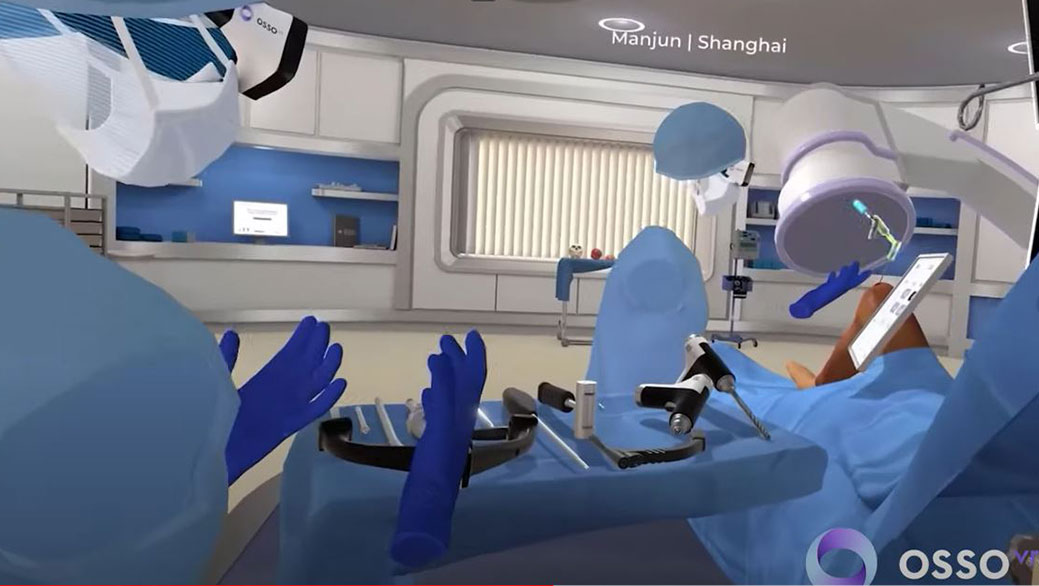Extended Realities
Extended reality (XR) is a collective term that covers virtual, augmented, diminishing, and mixed reality. Simply put, XR enables us to interact with and experience an increasingly digital world with the help of a wearable or handheld device. Accelerated by the pandemic, many aspects of our lives – work, education, socializing, shopping, leisure – moved online. With XR technologies advancing they will continue to do so.
RECENT DEVELOPMENTS
The landscape of new realities is ever-growing. A basic understanding of the differences and interdependencies between metaverse, AR (augmented reality), VR (virtual reality), MR (mixed reality), XR (extended reality), DR (diminished reality), and many other Rs to come helps to review the future of the field and implications for Greiner’s business.
- The Metaverse is a post-reality, multi-user environment that incorporates various aspects of new realities. Based on technologies such as VR and AR it allows multi-sensory, real-time, and seamless interactions between digital objects and people in a virtual universe.
- AR digitally alters or adds features to our existing environment. Users of AR remain oriented toward their physical surroundings. It can be experienced via wearables, tablets, or smartphones.
- VR can be experienced via head-mounted devices or smart glasses. With the help of those wearables, it immerses users fully into a virtual environment that is artificially created or imitates real-world surroundings other than the user’s current surroundings.
- MR describes environments or systems that blend the natural perception of a user with an artificial (computer-generated) perception. The experiences do not take place in the real nor virtual world but are a mix of the two.
- DR is AR, but the other way round. It leaves the user anchored in the physical surroundings but suppresses visuals, sounds, or other sensory elements like an advertisement.
- XR is a “catch-all” term for AR, VR, MR, and DR.
One of the first industries that used XR was gaming. Driven by the pandemic, offers for XR content are diversified. Several new services popped up like virtual concerts, virtual shops, virtual doctor offices, virtual offices, virtual real estate, virtual hotels, virtual education, and many more. In a business context, we have especially seen AR in manufacturing which helps with overlaid instructions, employee training to bridge the increasing skill gap, and many more. The latest examples are already present at Greiner.
Recently, with Marc Zuckerberg’s pitch for the metaverse and the renaming of the Facebook Group in Meta, especially VR was brought into the limelight. 3D spaces, avatars, and gamification fit well into virtual spaces. Additionally, lighter VR headsets, smart glasses, and even smart contact lenses are underway to make the new realities more accessible. Recently, a start-up developed smart glasses that are more than a display but serve as tiny computers themselves. New devices enable eye-tracking technology that will let us control software with eyeball movements and, thus, non-verbal interaction. Other companies work on enabling realistic movements within virtual spaces or haptic feedback.
IMPLICATIONS FOR THE HEALTH INDUSTRY
Recent developments show that XR is becoming more relevant in medicine. XR offers many possibilities for medicine and healthcare, for example in education like training of surgeons on 3D models or even 3D twins of patients, in patient care management like relaxing patients during a treatment, real-time guidance or vein visualization, in pain management, in rehabilitation and therapy procedures or in curing post-traumatic stress disorder. Statista predicts that the European AR and VR market will be worth $20.9billion by 2025, and back in 2016 Goldman Sachs stated that healthcare will be a key sector for its adoption.
However, there are still some hurdles to master such as accessibility of hardware and software, quality standards in health care, or insurance coverage.
First, researchers found that a barrier to bringing XR to medicine is that physicians and patients report that especially VR hardware and software are hard to use. Additionally, some feel dizzy after several minutes of usage. However, new products with easy accessibility and usability are developed and tailored to the needs of patients in all age groups.
Second, currently, XR systems often lack essential quality standards such as randomized, controlled clinical trials. Moreover, most XR studies are based on a small sample size and were not tested blindly. Though, standards are increasing. We have seen several XR therapies that have been approved by FDA and the EU.
Third, there is an unsolved topic of affordability. Most patients need to for pay XR treatment out of their private funds. XR therapy forms are not yet covered by public or private insurance systems. However, the equipment might be expensive for a single patient but affordable for a doctor and, thus, costs for the individual could be lowered.
Fourth, it is yet to determine how (heavy) usage of XR will affect mental health. Gartner predicts that 25% of people will spend at least one hour per day in the metaverse by 2026. We have seen a decrease in mental health due to intensive use of and addiction to social media. How will the metaverse affect our well-being?
Anyhow, once the essential technical and qualitative issues are solved, XR could disrupt medical education, and many forms of therapy and expand the capabilities of telemedicine. Even if technical problems still need to be solved, we do see many companies and start-ups which already started to experiment and launch products and services like surgical training by OSSO VR, vein detection by AccuVein, physical therapy by BehaVR, or treatment for mental health issues by Neuro Rehab VR. Neither of these therapies requires that patients travel to a clinic for treatment, thus, the possibilities for remote care will be further expanded.
MICROTRENDS
MEDICAL EDUCATION AND TRAINING: OSSO VR OFFERS SURGICAL TRAINING
Source:
Other XR training:
The San Francisco-based scale-up OSSO VR is a virtual reality surgical simulation training and assessment platform to improve outcomes and democratize access to surgical education. OSSO VR specializes in hyper-realistic, haptic-enhanced, hands-on interactivity and design. It provides medical device companies and healthcare professionals with new ways to share, practice, and learn new skills and procedures using virtual reality. The idea is to go from rare to routine in a virtual setting. As of today, the company has been funded with $110 million.

TELEMEDICINE: NASA „BEAMED“ A HOLOGRAM OF A DOCTOR TO THE ISS
Source:
In October 2021, NASA flight surgeon Dr. Schmid, and industry Partner De La Pena among their teams were the first human beings to be “holoported” from Earth into space. Using the Microsoft Hololens Kinect camera and a personal computer with custom software astronaut Thomas Pesquet had a two-way conversation with live images of Schmid and De La Pena placed in the middle of the International Space Station. This was the first holoportation handshake from Earth in space. Holoportation is a type of capture technology that allows high-quality 3D models of people to be reconstructed, compressed, and transmitted live anywhere in real-time.

MENTAL HEALTH: BEHAVR USES VR FOR MENTAL AND BEHAVIORAL HEALTH TREATMENTS
Link:
Other services:
The US-based VR company BehaVR translates science into immersive and engaging XR therapeutics for mental and behavioral health treatments. Patients with mental health issues can choose from a variety of therapy solutions using VR headsets for the treatment of stress or addictions. In cooperation with a Japanese pharmaceutical company, prescription digital therapeutics are being developed which are supposed to be able to be prescribed by US doctors after FDA approval. In the VR environment, patients get to see calming surroundings or play games to reduce their anxieties.

THERAPY: NEURO REHAB VR USES VR IN PHYSICAL THERAPY
Link:
Other therapy offers:
Neuro Rehab VR envisioned a clinic where patients use the latest technology to speed up their physical recovery. Their XR therapy system provides a fun, motivating, and highly engaging therapy experience for patients. The start-up claims that using its system improves therapist productivity, patient satisfaction, and access to quantitative progress data with reimbursable codes. The virtual environments are customizable and adapt to each patient’s specific needs, ability, and targeted therapy plan.

SOURCES
INFORMATION
FTI_Tech_Trends_2022_Book06.pdf
FTI_Tech_Trends_2022_Book03.pdf
builtin.com/healthcare-technology
forbes.com/sites/elizabethhowell1
Greiner Technology & Innovation (2021): Trends in Motion, pp. 36.
Rohrbeck Heger Reports (2022): The Future of Digital Healthcare, p. 5
PICTURES
Main Picture: Getty Images
Microtrend 1: ossovr.com
Microtrend 2: nasa.gov
Microtrend 3: behavr.com
Microtrend 4: neurorehabvr.com

